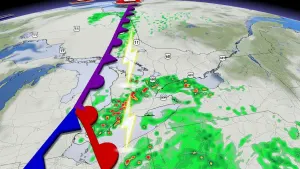
Stray dog found cuddling orphaned kittens on freezing night in Ontario
Many are calling this stray dog a hero after it was found cuddling five orphaned kittens that were stuck in the snow during a chilly night in Chatham-Kent, Ontario.
The animals were found in the cold last weekend by a passerby who then brought the animals to the Pet and Wildlife Rescue shelter.
The shelter shared a photo of the animals safely indoors and added the caption, “Our stray sweetheart is keeping her ‘babies’ safe at the shelter tonight!”

Credit: Pet and Wildlife Rescue
Last weekend there was a light layer of snow on the ground and temperatures were around -4°C with the wind chill dipping into the minus teens.
While certain animals and breeds can handle a variety of winter conditions, the frigid weather was dangerous for the newborn kittens.

Credit: Pet and Wildlife Rescue
This incident has reminded many that winter weather calls for additional precautions when it comes to taking pets outdoors.
Dr. Gary Landsberg, a veterinarian behaviourist who has been practicing for more than 30 years, told The Weather Network that the dangerous weather threshold for outdoor play is around -10°C to -15°C, no matter what kind of breed you have.
Although certain sled dogs can remain outside for hours, not all dogs fare as well in the snow. "Breeds with short hair, smaller breeds and breeds that aren't used to spending time outside are usually more susceptible to the cold conditions," he says.
SEE ALSO: 'Guardian angel' roofers save woman from drowning in icy Red River
KNOW WHEN YOUR PET NEEDS TO COME INSIDE
Inspecting your pet's feet can help you know when it is too cold for them. If they look cold or are starting to walk on three paws, get your furry friend indoors.
"It's important to be with your pet outdoors so you can observe shaking or stopping of movement," Dr. Landsberg says. "Extreme signs can include frostbite on the tips of the ears or discoloured paws."
PROTECTIVE CLOTHING: MORE THAN JUST A FASHION STATEMENT
Another way to protect your pet against the frigid air is to bundle them up in warm clothing. "Depending on the breed (particularly short hairs), it's not a bad idea to consider a sweater, vest or booties." Keep in mind, though, that not all pets will take kindly to clothing and you may have to spend several days or weeks training your animal to accept their new accessories.
Booties will keep your dog insulated while guarding against rough road salt. These pellets can stick in between your pet's paws, which can be irritating or make it difficult to walk. Dr. Landsberg says it can be challenging to remove the salt or chunks of ice, but a basin of lukewarm water will likely do the trick.
WARMING UP YOUR PETS
If you discover that your pet has become chilled after some time outdoors, Dr. Landsberg recommends treating your pet like you would a young child or baby.
“If your dog is small enough, wrap it in a big towel or blanket and cuddle it and dry it off as thoroughly as possible. When the animal wants to play and move around again, that's when you'll know everything is back to normal.”
Here are some other tips to keep in mind:
Do not leave your animal unsupervised in cold weather.
Make sure to check the forecast and find out if there's a cold weather alert in your area.
Do not leave your pet in a cold vehicle.
Observe your pet for any cold-related symptoms.
Keep your pet active when they are outside.










